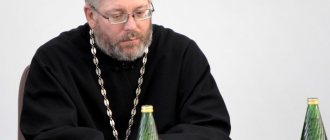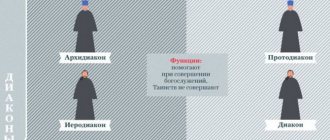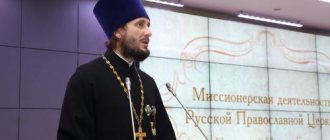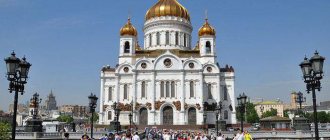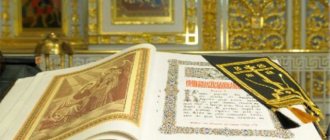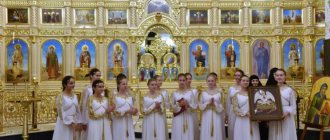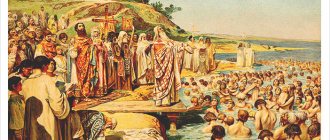The beginning of the church renovationist movement
Estimated reading time: 4 minutes.
On March 7, 1917, the movement of church “renovationists” began in Petrograd - the All-Russian Union of Democratic Orthodox Clergy and Laity was created, led by priests A. I. Vvedensky, A. I. Boyarsky, I. Egorov. They attempted church reforms, but the result of these attempts was tragic.
By the beginning of the 20th century, many clergy began talking about the need for reforms in the Church. The years of the First Russian Revolution became for the clergy a time of hope for the revival of Orthodoxy, which meant, first of all, gaining independence in resolving internal church affairs. Even the members of the Synod, contrary to the position of the Chief Prosecutor, in March 1905 unanimously spoke out in favor of reforms, for which they considered it necessary to convene the Local Council as soon as possible.
But in 1917, many were confused. Most reformers wanted the state to help the Church free itself from supporters of the old understanding of church life.
For its part, the “Union of Democratic Clergy and Laity” proclaimed the main goal of the movement “to be in unity with the people in the great work of creating a new political system, in which all pressing religious, cultural, political and socio-economic issues would be resolved in the best possible way.” .
But the Bolsheviks who came to power decided to use the church liberals for their own purposes - to destroy the Patriarchal Church, in which they succeeded.
In preparation for the confiscation of church values, the authorities, in order to avoid a new civil war, now religious, through the hands of renovationists, created a puppet church administration completely controlled by the regime.
On the night of May 12, 1922, priests Alexander Vvedensky, Alexander Boyarsky and Evgeny Belkov, accompanied by employees of the GPU, arrived at the Trinity Metochion in Moscow on Samotek, where Patriarch Tikhon was kept under house arrest, and accused him of a dangerous and rash policy that led to confrontation between the Church and state, demanded that he renounce his powers during the arrest. And the patriarch signed a resolution on the temporary transfer of church power to Metropolitan Agafangel (Preobrazhensky) of Yaroslavl.
And already on May 14, “An Appeal to the Believing Sons of the Orthodox Church of Russia” appeared in Izvestia, demanding a trial of “the perpetrators of church destruction” and a statement about ending the “civil war of the Church against the state.”
The next day, the delegation of the renovationists was received by the Chairman of the All-Russian Central Executive Committee, Mikhail Kalinin. The establishment of a new Higher Church Administration (HCU), consisting entirely of renovationists, was immediately announced. And to make it easier for them to seize the patriarchal office, the patriarch himself was transported to the Donskoy Monastery.
Directives were sent from the secretariat of the Central Committee of the RCP(b) to the localities on support for the renovationist structures being created. The GPU actively put pressure on the ruling bishops, forcing them to recognize the VCU and the “Living Church” established in parallel with it; persecution began against the “Tikhon’s” clergy.
In the photo in the center is A.I. Vvedensky
The meaning of the renovation movement itself was seen by its inspirers in the liberation of the clergy “from the deadening oppression of monasticism,” which prevents them from “getting into their hands the bodies of church government and certainly gaining free access to the rank of bishop. But like any schismatics, they immediately began to split into “talks.”
Already in August 1922, Bishop Antonin (Granovsky), chairman of the VCU, also organized the “Union of Church Revival” (UCR), which saw its support not in the clergy, but in the laity - as “the only element” capable of “charging church life with revolutionary religious energy." The charter of the Central Eastern Church promised its followers “the broadest democratization of Heaven, the widest access to the bosom of the Heavenly Father.”
Vvedensky and Boyarsky organized the “Union of Communities of the Ancient Apostolic Church” (SODATS). Many smaller church reform groups appeared, and each had its own program of church reforms aimed at a radical renewal of the Russian Orthodox Church.
By the end of 1922, the renovationists, with the help of the authorities, captured two-thirds of the 30 thousand churches operating at that time. As the authorities had hoped, the campaign of looting churches and desecration of shrines did not cause mass popular protests simply because the Church was split from within, and individual pockets of resistance could easily be destroyed by the forces of the GPU.
In May 1923, in Moscow, in the Cathedral of Christ the Savior, the first Renovation Council was held, which passed a resolution supporting Soviet power and announced the defrocking of the “former Patriarch” Tikhon. The patriarchate was abolished as a “monarchical and counter-revolutionary way of leading the Church,” the institution of a white (married) episcopate and the Gregorian calendar were introduced, and the VCU was transformed into the Supreme Church Council (SCC).
Naturally, Patriarch Tikhon did not recognize the decisions of the Renovation Council, and anathematized the Renovationists themselves as an “illegal gathering” and “an institution of the Antichrist.”
Then, in order to counter the “Tikhonovism,” the authorities decided to give the renovationist schism a more respectable appearance, subordinating all its movements to a single central body: the All-Russian Central Council was transformed into the “Holy Synod,” and all renovationist groups were ordered to dissolve and unite their members into the “Renovation Church.” . The “Living Church,” which did not submit to this decision, simply ceased to exist without the support of the authorities.
In June 1924, the renovationist “Pre-Conciliar Meeting” appealed to the Council of People's Commissars with a request to grant clergy the rights of members of trade unions, to allow children under 11 to be taught the Law of God, to conduct civil registration, and to return confiscated miraculous icons and relics to churches. Naturally, all this was refused.
In October 1925, the renovationists held their second council, at which they officially abandoned all previously announced reforms not only in the field of dogma and worship, but also in the field of the liturgical calendar.
After this council, renovationism began to catastrophically lose its supporters.
Ultimately, in 1935, the VCU itself dissolved, and the renovationists were hit by a general wave of anti-church repressions, and mass arrests of their episcopate, clergy and active laity began. The final blow to the movement was the decisive support by the authorities of the Patriarchal Church in September 1943. By the end of the war, all that remained of all renovationism was the parish of the Church of Pimen the Great in Novye Vorotniki (New Pimen) in Moscow.
Revolution of 1917
After the February Revolution of 1917, Renovationism gained great strength and popularity, but for now it operated within the framework of a single church. Some of the renovationists sympathized with the revolution for ideological reasons, considering it necessary to combine Christianity with its commandment “let him who shall not work, let him not eat!” and socialism. Others hoped to make a career in the church hierarchy with the help of the new authorities. Individuals aspired directly to a political career. Thus, Archpriest Alexander Vvedensky organized the “Workers’ and Peasants’ Christian Socialist Party,” which even put forward its list in the elections to the Constituent Assembly in the fall of 1917. Both had high hopes for the Local Council of the Russian Orthodox Church, which opened in August 1917 in the Assumption Cathedral of the Moscow Kremlin. The Renovationists were supported by a member of the Provisional Government, Chief Prosecutor of the Synod V. Lvov. The majority of the Council took a conservative position. By restoring the patriarchate, the Council disappointed the renovationists. But they liked the decree of the Council of People's Commissars on the separation of church and state. In it they saw the opportunity to carry out church reforms under the new government. During the Civil War, the Bolsheviks had no time for a systematic struggle against the traditional church. When the aforementioned Alexander Vvedensky (the future head of the renovationist Russian Orthodox Church in the rank of metropolitan) in 1919 visited the chairman of the Petrosoviet and the Comintern G.E. Zinoviev and suggested that he conclude a “concordat” between the renovationist church and the Soviet government, the authoritative Bolshevik replied that this was not yet appropriate. But if the renovationists manage to create a strong organization, it will receive the support of the authorities, Zinoviev assured.
Organization of the Renovation Church
After the victory in the civil war, the Bolsheviks were left in the ashes, and in order to have at least something to reign over, they had to raise the country from the ruins they had created. The wealth of the Russian Church accumulated over centuries was seen as one of the important sources of funds. There was also a reason: mass famine in the Volga region (due to the previously pursued policies of the Bolsheviks). A campaign began in the Soviet press for the confiscation of church valuables for the benefit of the starving. Renovationists were actively involved in it. As is now reliably known, many of them were already part-time employees of the GPU. Moreover, some of them, before the revolution, were listed as prominent participants in the “Union of the Russian People” and other Black Hundred organizations. Perhaps nowhere more powerfully than in the Renovationist Church did this “pragmatic” “red-black bloc” assert itself. The leaders of the renovationists, with the support of the GPU, created the Supreme Church Administration (later the Supreme Church Council, and then the Holy Synod) and called for a trial of Patriarch Tikhon, but at the same time presented themselves as the only legitimate leadership of the church. True, several movements immediately emerged among the renovationists: “Living Church”, “Union of Church Revival”, etc. Disagreements between them were skillfully maintained by the security officers, who were not interested in a single church organization, even if loyal to the authorities. The renewal movement was still fed by impulses from below, from believers who vaguely desired some kind of reform of Orthodoxy. Therefore, many groups managed to overcome differences and convene the Second Local All-Russian Council in April-May 1923 in the Moscow Cathedral of Christ the Savior. At it, Patriarch Tikhon was defrocked, the transition to a civil calendar was announced, marriages of bishops and remarriages of widowed priests were allowed, and monasticism was abolished. Some of the renovationist churches went even further: they removed the iconostases and choirs, and moved the altar to the center of the temples. Priest barbering became fashionable among the Renovationists.
Favor of Communists towards Church Conservatives
Meanwhile, the Bolsheviks saw that the renovationist church enjoyed quite a lot of support from believers (more than 12 thousand parishes were represented at the 1923 Council) and, instead of killing, as they expected, the church as such, they gave it new life. It was difficult to accuse the Renovationist Church of being retrograde and inert, but these were precisely the pain points that anti-church propaganda hit. Therefore, the Bolshevik leadership decides to partially legalize the traditional church with its conservative hierarchy and stagnant customs. Already in June 1923, they released Patriarch Tikhon from prison and allowed his clergy to serve. Many believers began to return to the traditionalists. For some time the Bolsheviks stirred up competition between both churches. The renovationists are trying to enlist the support of the Patriarchate of Constantinople, convene an Ecumenical Council of Orthodox Churches in Jerusalem, win (with the help of Soviet diplomacy) a number of foreign parishes, and finally convene their last local council in October 1925. It already shows the decline of the Renovationist Church. Since the late 20s, she has been dragging out a miserable existence. At the end of the 30s, repressions unfolded against many of its hierarchs, especially those who had previously collaborated with the Bolshevik secret police - the NKVD removed witnesses. Renovationist churches are closing en masse. With the beginning of the Great Patriotic War, the Renovationist Church, like the traditional one, experienced a rise. But in 1943, Stalin made the final choice in favor of the traditionalists. Through the efforts of the state, in 1946 the Renovationist Church disappeared, its surviving clergy and parishioners transferred to the Russian Orthodox Church MP or left the religion. The main reason for the collapse of the renovation movement should be considered that it turned out to be closely connected with the Bolshevik secret police and could not give people a spiritual alternative to the dictatorship established over Russia. At that time, adherence to traditional Orthodoxy became one of the forms of passive resistance to Bolshevism. Those who were loyal to the Soviet regime, for the most part, did not need religion. Under other conditions, renovationism could have great potential.


